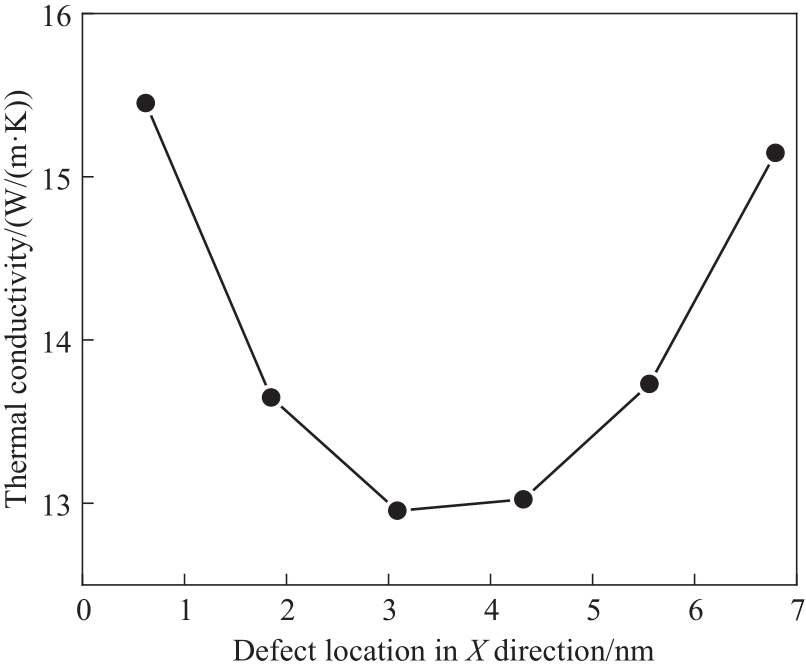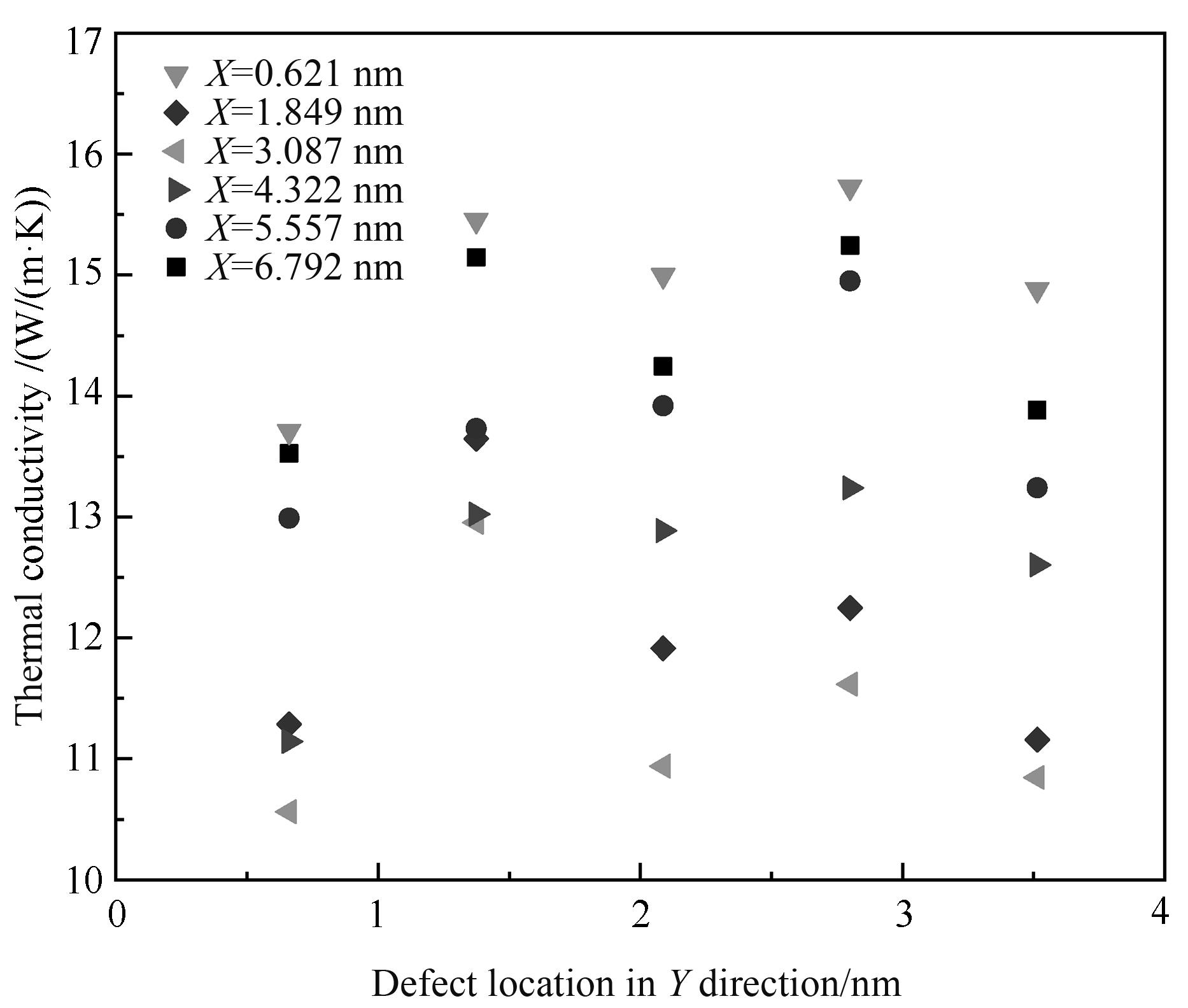化工学报 ›› 2023, Vol. 74 ›› Issue (6): 2708-2716.DOI: 10.11949/0438-1157.20230242
• 材料化学工程与纳米技术 • 上一篇
刘远超1,2( ), 蒋旭浩1, 邵钶1, 徐一帆1, 钟建斌1, 李耑1
), 蒋旭浩1, 邵钶1, 徐一帆1, 钟建斌1, 李耑1
收稿日期:2023-03-13
修回日期:2023-05-08
出版日期:2023-06-05
发布日期:2023-07-27
通讯作者:
刘远超
作者简介:刘远超(1977—),男,博士,副教授,liuyuanchao@bipt.edu.cn
基金资助:
Yuanchao LIU1,2( ), Xuhao JIANG1, Ke SHAO1, Yifan XU1, Jianbin ZHONG1, Zhuan LI1
), Xuhao JIANG1, Ke SHAO1, Yifan XU1, Jianbin ZHONG1, Zhuan LI1
Received:2023-03-13
Revised:2023-05-08
Online:2023-06-05
Published:2023-07-27
Contact:
Yuanchao LIU
摘要:
基于分子动力学模拟方法,对石墨炔纳米带(GYNR)的热输运特性进行了深入研究,重点探讨了几何尺寸、缺陷类型及缺陷的位置(水平方向和垂直方向、苯环与乙炔链)和排列方式等对声子热输运的影响规律,揭示并分析了其声子热输运调控机理。研究结果表明,理想GYNR的热导率仅为18.22 W/(m·K),且相比于石墨烯,GYNR随尺寸增大热导率仅升至21.37 W/(m·K),对几何尺寸依赖较小;对于缺陷类型,空位缺陷的存在相比于氮掺杂对热导率抑制更强,可低至9.19 W/(m·K);对于缺陷位置,位于苯环上或靠近纳米带边界时相比于炔链热导率更低;多个缺陷若以平行分布相比于三角形结构分布可获得更低的热导率,低于8.00 W/(m·K)。研究结果可以为石墨炔材料在纳米器件的热电领域开发、应用及调控等方面提供理论支持和参考。
中图分类号:
刘远超, 蒋旭浩, 邵钶, 徐一帆, 钟建斌, 李耑. 几何尺寸及缺陷对石墨炔纳米带热输运特性的影响[J]. 化工学报, 2023, 74(6): 2708-2716.
Yuanchao LIU, Xuhao JIANG, Ke SHAO, Yifan XU, Jianbin ZHONG, Zhuan LI. Influence of geometrical dimensions and defects on the thermal transport properties of graphyne nanoribbons[J]. CIESC Journal, 2023, 74(6): 2708-2716.
| 宽4.12 nm | 长14.39 nm | |||
|---|---|---|---|---|
| 长度/nm | 原子数 | 宽度/nm | 原子数 | |
| 14.39 | 1538 | 4.12 | 1538 | |
| 22.41 | 2498 | 6.68 | 2458 | |
| 34.53 | 3858 | 9.25 | 3378 | |
| 44.51 | 4978 | 11.82 | 4298 | |
| 53.07 | 5938 | |||
表1 不同长度和宽度的AGYNRs
Table 1 AGYNRs with different lengths and widths
| 宽4.12 nm | 长14.39 nm | |||
|---|---|---|---|---|
| 长度/nm | 原子数 | 宽度/nm | 原子数 | |
| 14.39 | 1538 | 4.12 | 1538 | |
| 22.41 | 2498 | 6.68 | 2458 | |
| 34.53 | 3858 | 9.25 | 3378 | |
| 44.51 | 4978 | 11.82 | 4298 | |
| 53.07 | 5938 | |||

图11 热导率随X轴空位缺陷位置变化关系(固定缺陷在Y轴Y=1.374 nm)
Fig.11 Change of thermal conductivity with the position of vacancy defect on X-axis (fixed defect on Y-axis Y=1.374 nm)

图12 热导率随X轴上空位缺陷位置变化关系(固定四组缺陷位于不同Y轴位置)
Fig.12 Change of thermal conductivity with the position of vacancy defect on X-axis (the fixed four groups of defects are located in different Y-axis positions)

图13 热导率随Y轴空位缺陷位置变化关系(固定缺陷在X轴X=0.621 nm)
Fig.13 Change of thermal conductivity with the position of Y-axis vacancy defect (fixed defect in X-axis X=0.621 nm)

图14 热导率随Y轴空位缺陷位置变化关系(固定六组缺陷位于不同X轴位置)
Fig.14 Change of thermal conductivity with the position of vacancy defect on Y-axis (the fixed six groups of defects are located in different X-axis positions)
| 1 | Su Z X, Zhang M L, Xu P H, et al. Opportunities and strategies for multigrade waste heat utilization in various industries: a recent review[J]. Energy Conversion and Management, 2021, 229: 113769. |
| 2 | Liu Z H, Gao W H, Guo F K. Challenges for thermoelectric power generation: from a material perspective[J]. Materials Lab, 2022, 1: 220003. |
| 3 | Baughman R H, Eckhardt H, Kertesz M. Structure-property predictions for new planar forms of carbon: layered phases containing sp2 and sp atoms[J]. The Journal of Chemical Physics, 1987, 87(11): 6687-6699. |
| 4 | Li G X, Li Y L, Liu H B, et al. Architecture of graphdiyne nanoscale films[J]. Chemical Communications, 2010, 46(19): 3256-3258. |
| 5 | Wang J, Wang K, Yang Z, et al. Effective stabilization of long-cycle lithium-sulfur batteries utilizing in situ prepared graphdiyne-modulated separators[J]. ACS Sustainable Chemistry & Engineering, 2020, 8(4): 1741-1750. |
| 6 | Gao J, Li J F, Chen Y H, et al. Architecture and properties of a novel two-dimensional carbon material-graphtetrayne[J]. Nano Energy, 2018, 43: 192-199. |
| 7 | Shandilya P, Mandyal P, Kumar V, et al. Properties, synthesis, and recent advancement in photocatalytic applications of graphdiyne: a review[J]. Separation and Purification Technology, 2022, 281(15): 119825. |
| 8 | Li X, Li B H, He Y B, et al. A review of graphynes: properties, applications and synthesis[J]. New Carbon Materials, 2020, 35(6): 619-629. |
| 9 | Qin X F, Shao Z G, Wang C L, et al. Electronic and optical properties of lithium-decoratedδ-graphyne from first principles[J]. Optik, 2020, 216: 164898. |
| 10 | Desyatkin V G, Martin W B, Aliev A E, et al. Scalable synthesis and characterization of multilayer γ-graphyne, new carbon crystals with a small direct band gap[J]. Journal of the American Chemical Society, 2022, 144(39): 17999-18008. |
| 11 | 邵钶, 刘远超, 钟建斌. 碳纳米管和石墨烯热输运性质的实验及分子动力学模拟研究进展[J]. 化工新型材料, 2021, 49(7): 194-199. |
| Shao K, Liu Y C, Zhong J B. Research progress on the thermal transport property of carbon nanotubes and graphene by experiment and molecular dynamics simulation[J]. New Chemical Materials, 2021, 49(7): 194-199. | |
| 12 | Tan X J, Shao H Z, Hu T Q, et al. High thermoelectric performance in two-dimensional graphyne sheets predicted by first-principles calculations[J]. Physical Chemistry Chemical Physics, 2015, 17(35): 22872-22881. |
| 13 | Ouyang T, Chen Y P, Liu L M, et al. Thermal transport in graphyne nanoribbons[J]. Physical Review B, 2012, 85(23): 235436. |
| 14 | Zhang Y Y, Pei Q X, Wang C M. A molecular dynamics investigation on thermal conductivity of graphynes[J]. Computational Materials Science, 2012, 65: 406-410. |
| 15 | Pan L D, Zhang L Z, Song B Q, et al. Graphyne- and graphdiyne-based nanoribbons: density functional theory calculations of electronic structures[J]. Applied Physics Letters, 2011, 98(17): 173102. |
| 16 | Cui C F, Ouyang T, Tang C, et al. Bayesian optimization-based design of defect gamma-graphyne nanoribbons with high thermoelectric conversion efficiency[J]. Carbon, 2021, 176: 52-60. |
| 17 | 李威, 冯妍卉, 张欣欣, 等. 掺杂、吸附和空位缺陷对碳纳米管导热的影响[J]. 化工学报, 2012, 63(S1): 75-83. |
| Li W, Feng Y H, Zhang X X, et al. Influences of doping, adsorption and vacancy defects on heat conduction of carbon nanotubes[J]. CIESC Journal, 2012, 63(S1): 75-83. | |
| 18 | Feng T L, Ruan X L, Ye Z Q, et al. Spectral phonon mean free path and thermal conductivity accumulation in defected graphene: the effects of defect type and concentration[J]. Physical Review B, 2015, 91(22): 224301. |
| 19 | Ouyang T, Hu M. Thermal transport and thermoelectric properties of beta-graphyne nanostructures[J]. Nanotechnology, 2014, 25(24): 245401. |
| 20 | Li Y J, Li Y L. Chemical modification and functionalization of graphdiyne[J]. Acta Physico-Chimica Sinica, 2018, 34(9): 992-1013. |
| 21 | Ren J, Zhang N C, Liu P P. Li adsorption on nitrogen-substituted graphyne for hydrogen storage[J]. Fullerenes, Nanotubes and Carbon Nanostructures, 2020, 29(3): 212-217. |
| 22 | Hou N, Fang X H, Feng R. DFT study of the influence of boron/nitrogen substitution on the electronic and nonlinear optical properties of the benzene-substituted graphdiyne fragment[J]. Computational and Theoretical Chemistry, 2022, 1209: 113629. |
| 23 | Zhang T T, Li J H, Cao Y W, et al. Tailoring thermal transport properties of graphene by nitrogen doping[J]. Journal of Nanoparticle Research, 2017, 19(2): 48. |
| 24 | 兰生, 李焜, 高新昀. 基于分子动力学的石墨炔纳米带空位缺陷的导热特性[J]. 物理学报, 2017, 66(13): 136801. |
| Lan S, Li K, Gao X Y. Based on the molecular dynamics characteristic research of heat conduction of graphyne nanoribbons with vacancy defects[J]. Acta Physica Sinica, 2017, 66(13): 136801. | |
| 25 | 刘东静, 王韶铭, 杨平. 石墨烯/碳化硅异质界面热学特性的分子动力学模拟[J]. 物理学报, 2021, 70(18): 187302. |
| Liu D J, Wang S M, Yang P. Thermal property of graphene/silicon carbide heterostructure by molecular dynamics simulation[J]. Acta Physica Sinica, 2021, 70(18): 187302. | |
| 26 | 高宇飞. 低维纳米材料热输运性能的分子模拟[D]. 哈尔滨: 哈尔滨工业大学, 2013. |
| Gao Y F. Molecular simulation for the thermal transport properties of low-dimensional nanomaterials[D]. Harbin: Harbin Institute of Technology, 2013. | |
| 27 | Schelling P K, Phillpot S R, Keblinski P. Comparison of atomic-level simulation methods for computing thermal conductivity[J]. Physical Review B, 2002, 65(14): 144306. |
| 28 | Wan Y C, Xiong S Y, Ouyang B, et al. Thermal transport engineering in graphdiyne and graphdiyne nanoribbons[J]. ACS Omega, 2019, 4(2): 4147-4152. |
| 29 | Yang X X, Dai Z H, Zhao Y C, et al. Phonon thermal transport in a class of graphene allotropes from first principles[J]. Physical Chemistry Chemical Physics, 2018, 20(23): 15980-15985. |
| 30 | Liu D J, Yang P, Yuan X M, et al. The defect location effect on thermal conductivity of graphene nanoribbons based on molecular dynamics[J]. Physics Letters A, 2015, 379(9): 810-814. |
| 31 | Zhan H F, Zhang Y Y, Bell J M, et al. Structure-mediated thermal transport of monolayer graphene allotropes nanoribbons[J]. Carbon, 2014, 77: 416-423. |
| [1] | 宋嘉豪, 王文. 斯特林发动机与高温热管耦合运行特性研究[J]. 化工学报, 2023, 74(S1): 287-294. |
| [2] | 宋明昊, 赵霏, 刘淑晴, 李国选, 杨声, 雷志刚. 离子液体脱除模拟油中挥发酚的多尺度模拟与研究[J]. 化工学报, 2023, 74(9): 3654-3664. |
| [3] | 胡建波, 刘洪超, 胡齐, 黄美英, 宋先雨, 赵双良. 有机笼跨细胞膜易位行为的分子动力学模拟研究[J]. 化工学报, 2023, 74(9): 3756-3765. |
| [4] | 赵佳佳, 田世祥, 李鹏, 谢洪高. SiO2-H2O纳米流体强化煤尘润湿性的微观机理研究[J]. 化工学报, 2023, 74(9): 3931-3945. |
| [5] | 刘远超, 关斌, 钟建斌, 徐一帆, 蒋旭浩, 李耑. 单层XSe2(X=Zr/Hf)的热电输运特性研究[J]. 化工学报, 2023, 74(9): 3968-3978. |
| [6] | 傅予, 刘兴翀, 王瀚雨, 李海敏, 倪亚飞, 邹文静, 雷月, 彭永姗. F3EACl修饰层对钙钛矿太阳能电池性能提升的研究[J]. 化工学报, 2023, 74(8): 3554-3563. |
| [7] | 曾如宾, 沈中杰, 梁钦锋, 许建良, 代正华, 刘海峰. 基于分子动力学模拟的Fe2O3纳米颗粒烧结机制研究[J]. 化工学报, 2023, 74(8): 3353-3365. |
| [8] | 陈佳起, 赵万玉, 姚睿充, 侯道林, 董社英. 开心果壳基碳点的合成及其对Q235碳钢的缓蚀行为研究[J]. 化工学报, 2023, 74(8): 3446-3456. |
| [9] | 汪林正, 陆俞冰, 张睿智, 罗永浩. 基于分子动力学模拟的VOCs热氧化特性分析[J]. 化工学报, 2023, 74(8): 3242-3255. |
| [10] | 陈吉, 洪泽, 雷昭, 凌强, 赵志刚, 彭陈辉, 崔平. 基于分子动力学的焦炭溶损反应及其机理研究[J]. 化工学报, 2023, 74(7): 2935-2946. |
| [11] | 邢美波, 张中天, 景栋梁, 张洪发. 磁调控水基碳纳米管协同多孔材料强化相变储/释能特性[J]. 化工学报, 2023, 74(7): 3093-3102. |
| [12] | 余娅洁, 李静茹, 周树锋, 李清彪, 詹国武. 基于天然生物模板构建纳米材料及集成催化剂研究进展[J]. 化工学报, 2023, 74(7): 2735-2752. |
| [13] | 葛加丽, 管图祥, 邱新民, 吴健, 沈丽明, 暴宁钟. 垂直多孔碳包覆的FeF3正极的构筑及储锂性能研究[J]. 化工学报, 2023, 74(7): 3058-3067. |
| [14] | 董明, 徐进良, 刘广林. 超临界水非均质特性分子动力学研究[J]. 化工学报, 2023, 74(7): 2836-2847. |
| [15] | 董茂林, 陈李栋, 黄六莲, 吴伟兵, 戴红旗, 卞辉洋. 酸性助水溶剂制备木质纳米纤维素及功能应用研究进展[J]. 化工学报, 2023, 74(6): 2281-2295. |
| 阅读次数 | ||||||
|
全文 |
|
|||||
|
摘要 |
|
|||||
 京公网安备 11010102001995号
京公网安备 11010102001995号